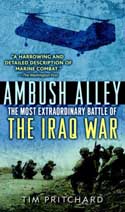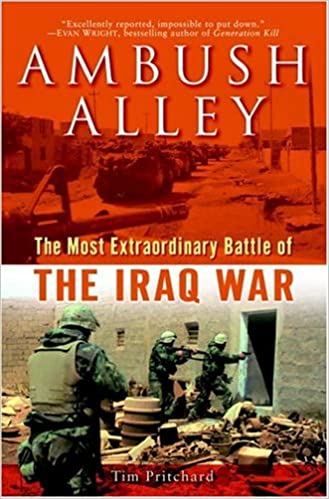Ambush Alley
 THE BATTLE THAT AMERICA NEARLY LOST
THE BATTLE THAT AMERICA NEARLY LOST
The New York Times (2006)
Pinpointing the moment that Iraq started to go wrong is a favorite pursuit of commentators and analysts anxious to explain to a confused American public how scenes of joyful Iraqis pulling down Saddam’s statue so quickly turned into images of car bombs, grieving mothers and burning US helicopters. In front of the Iraq Study Group some will argue it was a mistake to disband the Iraqi army and security forces. Others will say there are not enough troops on the ground to secure and stabilise Iraq. In most analyses however there is a tendency to treat the invasion and post-invasion of Iraq as separate entities. The invasion is generally portrayed as well-planned and successfully executed. The post-invasion strategy is characterized as ill-thought out, chaotic and undermanned and that, hidden somewhere in the weeks and months following the arrival of US forces in Baghdad, there lies a magic moment when Iraq somehow began to descend into chaos.
In fact, the fight to get to Baghdad, and the one which coalition forces have been engaged in ever since, have much in common. All the information about the nature of the trouble to come was apparent from the very first days of the war. If lessons learned then had been incorporated into military and political thinking, it would have injected a much needed dose of realism at an early stage.
Those lessons were best synthesized in a little-known, but bloody battle, fought in an obscure part of Iraq on day three of the war. It was a battle that America nearly lost.
It was dawn on March 23rd, 2003, when Marines from Task Force Tarawa approached the town of Nasiriyah in southern Iraq. They were tasked with a routine maneuver: taking two key bridges to open up a route to Baghdad. Nasiriyah was a predominantly Shia town that had rebelled against Saddam Hussein during the first Gulf War. The intelligence suggested that as soon as the Americans rolled into town, the city’s defenders would lay down their weapons and, as one Marine commander expressed it, “put flowers in our gun barrels, hold up their babies for us to kiss and give us the keys to the city.”
But when Task Force Tarawa’s lead units reached the outskirts they came across the burnt out remnants of several vehicles of the US Army’s 507th Maintenance Company. A captain in the 507th told wide-eyed Marine commanders how his convoy had taken a wrong turn at night, driven into Nasiriyah and been attacked by Iraqi fighters. Several US soldiers were still missing in the city, including a young army private, Jessica Lynch.
It was the fate of the missing Jessica Lynch that attracted all the attention in the days following. But it’s what happened to the Marines of Task Force Tarawa that is most instructive about the true nature of the Iraq war and the implications for what life would be like once US forces got to Baghdad.
As Marine units moved into Nasiriyah they were attacked by massed numbers of Iraqi fighters. To the surprise of Marines on the ground, few of the Iraqi combatants seemed to be wearing military uniforms. Many were dressed in the distinctive black pyjamas worn by Shia moslems and much of the gunfire came from dwellings flying black flags denoting them as Shia homes. And yet the Shias were supposed to be on the Americans’ side.
What’s more, as the Marines were drawn into a raging battle in the city center, more and more people seemed to come out of ordinary homes to take up arms. One group of young Marines, who became separated from the rest of their unit and were forced to commandeer a house in the middle of the city, found themselves under attack for several hours from what appeared to be armed civilians. They had been expecting to fight Iraqi soldiers. Instead they found themselves shooting at old men, women, even children.
Of course there were fanatical Sunni fedayeen troops and desperate foreign fighters who fought that day. But some of those who picked up weapons were also civilians intent on defending homes against foreign invaders. The potent and complex mix of insurgency; Sunni and Shia militants, foreign fighters and civilians, that causes such chaos in Iraq today, was already apparent during the battle of Nasiriyah.
Intelligence about the terrain was also sorely lacking. Marine tanks spearheading the maneuver took a route that led to a marshy bog where they sank, mired uselessly in thick mud, while the battle raged. It’s more than just a metaphor for coalition forces getting bogged down, post-invasion, in towns like Fallujah and Samarra. It was the product of a rush to arms without adequate intelligence or planning.
At one stage, in a “friendly fire” incident, US Air Force planes fired at Marines on the ground killing up to ten of them. Radio communications repeatedly failed. Units lost contact with each other and went missing in the city. Faced with an increasingly determined enemy, Marine commanders thought they might just lose the battle. It showed another truth, obscured during the march to Baghdad, but that has become strikingly apparent since. There is a limit to what armor and technology can do against a people with faith, who fight because they feel their country has been violated.
There were other incidents in Nasiriyah, minor ones at the time, which foreshadowed events that would become an international embarrassment. At one point, a Marine commander came across a gruesome scene: young Marines, standing over a pile of Iraqi corpses, taking photos of each other, thumbs up and grinning inanely to camera. One year later, there emerged the first photos of US soldiers grinning over the bodies of abused Iraqi prisoners.
But what was most striking at Nasiriyah in those very early days of the war was the absence of that grand coalescence of freedom deprived Iraqis who were to come forward and support coalition forces. At best, civilians stood by and watched the American war machine thunder into town. At worst, they ran to arms staches, grabbed AK47s and took to the streets. And that did not bode well for life in post-invasion Iraq. Instead of coming together, Iraqis would fall back into their faiths and tribes and end up killing coalition forces, and each other.
Eighteen Marines died in Nasiriyah that day in what turned out to be the bloodiest phase of the Iraq war. Four days later the city was finally declared secure. One week after that, American forces triumphantly entered Baghdad and helped topple Saddam’s statue. Everyone lauded the speed and efficiency with which US forces had fought their way to Baghdad. And the trauma of Nasiriyah was forgotten.
And that was a shame. If the intelligence from Nasiriyah had been gathered, recognised, and analysed more soberly early on, instead of trampled on in a rush of triumphalism, the lessons learned might have shown coalition forces a more realistic approach to the challenges of stabilising and rebuilding Iraq. Instead, we got a hubristic speech from President Bush from the deck of the USS Lincoln where he announced the end of major combat operations against the backdrop of a banner declaring “Mission Accomplished.”
Tim Pritchard is a journalist and the author of a book on the battle of Nasiriyah, “Ambush Alley, the Most Extraordinary Battle of the Iraq War.”


